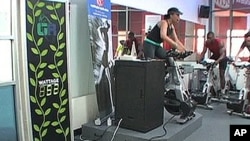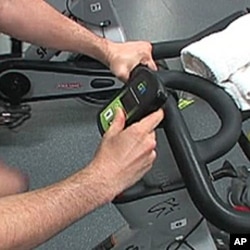Riders of a new kind of exercise bicycle can generate electric power for their fitness center's use while they burn their own calories.
The technology helps health clubs save money and also gives added incentive for the exercisers to work harder.
In a group exercise class at one of the Washington Sports Club's locations in Washington D.C., riders spin their bikes faster and faster following the instructor's command.
Jillian Cooney, a sports club for four years, enjoys the spinning class. But these days, she says, the group exercise is a little different.
"I think it is more challenging. I would not necessarily say it is more difficult but more challenging," says Cooney. "I challenge myself more with these levels than when I use the resistance."
The sports club's stationary cycles were recently retrofitted with so-called "Green Revolution" technology, which turns every bike into an electrical generator. The technology allows riders to generate power with every turn of the pedals.
"We put a generator on each bike in the group cycling studio so while the fitness enthusiasts are getting their workout," says Mike Curnyn, of The Green Revolution, a company based in the eastern U.S. state of Connecticut, "their energy is being captured and being converted to clean electricity that is being used to help power the health club."
Instead of turning a knob to adjust resistance, riders control the resistance levels of the bike with a touch-pad screen, which also shows how much energy the cycle has sent to the grid.
"We add this control panel. If you want to simulate you are climbing a hill, you would click the uphill button and now the resistance level will change," says Curnyn. "It can go up to level 20. Or if you wanted to be on a flat road and you wanted to sprint, then you could lower the resistance. The key is, by changing the resistance levels on the control panel, they are now controlling how much electricity they're producing."
No single rider generates a large amount of electricity in a one-hour session. But Curnyn says if you add in the bike next to yours, and the one next to that, and so on, you can see real results.
"Each person has the potential to generate about 100 watt-hours during their hour cycling class, so if you have 25 people in the class, you have the potential to create about 2 ½ to 3 kilowatts of electricity," says Curnyn. "And that is enough electricity to light all the lights in this large fitness room, or to light the air conditioning system that is being used to cool the health club."
Not only does this help the health club save money, it also provides added incentive for the exercisers to work harder.
"I like that since I am coming to the gym to work out anyway it is good that I get a work-out while also helping produce energy and cutting back on the power the gym has to use," says sports club member Jillian Cooney.
Michel Pranikof has tried the bike twice so far. "I really like it. This is really cool because you know that you are contributing to the environment. You are actually giving power, giving some power back."
The Green Revolution's first installation was a year and a half ago. Now, they have installations in about 60 facilities across the United States and Canada. The company is testing ways to apply the technology to other kinds of cardio-fitness devices, such as rowing machines and elliptical trainers.















